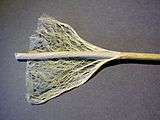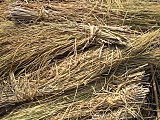Difference between revisions of "AY Honors/Mat Making/Answer Key"
Jomegat bot (talk | contribs) m (honor_header -> honor_desc) |
JadeDragon (talk | contribs) |
||
| Line 45: | Line 45: | ||
===Screw pine=== | ===Screw pine=== | ||
==3. Name plants that can be used for making dyes in your culture. Tell where they come from and how to prepare them for dying. == | ==3. Name plants that can be used for making dyes in your culture. Tell where they come from and how to prepare them for dying. == | ||
| − | ===Rattan=== | + | |
| + | There are many thousands of different plants that can be used for dying, including ones you can find in your own back yard or local forest. Roots, nuts and flowers are all common sources of dye. Take a look at [http://pioneerthinking.com/crafts/natural-dyes this list] for plants sorted by color and the source of these directions. This worldwide wiki can't tell you which plants are in YOUR culture, but with a little research you will know. | ||
| + | |||
| + | Here are some generalized directions that should work with most plants. Variation may be required for specific plants, and different cultures may do things somewhat differently. This assumes you will either dye the material before weaving or dye the entire finished mat at once. There are two main jobs - prepare the material and make the dye. | ||
| + | |||
| + | ===Preparing the Mat Material for Dyeing=== | ||
| + | |||
| + | You will likely need to prepare a simple Color Fixative: | ||
| + | |||
| + | a) Salt Fixative (for berry dyes) 1/2 cup salt to 8 cups cold water | ||
| + | |||
| + | b) Plant Fixatives (for plant dyes) 4 parts cold water to 1 part vinegar | ||
| + | |||
| + | Add material to be died to the fixative and simmer for an hour. Rinse the material and squeeze out excess. Rinse in cool water until water runs clear. | ||
| + | |||
| + | ===Making Dye=== | ||
| + | |||
| + | Step 1: Gather the plant material: blossoms should be in full bloom, berries ripe and nuts mature for best results | ||
| + | |||
| + | Step 2: Next chop your plant material into small pieces and put it in a suitable pot. Add twice as much water to your plant material. Bring to a boil, then simmer for about an hour. | ||
| + | |||
| + | Step 3: Strain with a metal strainer, colander, or cloth (depending on plant material, you want to get the big pieces out somehow). | ||
| + | |||
| + | Step 4: Add your prepared fabric or mat making material to be dyed (after the color fixative). For a stronger shade, allow material to soak in the dye overnight. | ||
| + | |||
| + | |||
| + | Here is one example to follow in your report. | ||
| + | |||
| + | ====Rattan==== | ||
The fruit of some rattans exudes a red resin called dragon's blood. This resin was used as a dye for violins, among other things. The resin normally results in a wood with a light peach hue. | The fruit of some rattans exudes a red resin called dragon's blood. This resin was used as a dye for violins, among other things. The resin normally results in a wood with a light peach hue. | ||
Revision as of 20:01, 24 September 2014
Mat Making
Approval authority:
Category:
Skill Level:
Year of Introduction:
![]()
Contents
1. In your culture name the materials which are used in mat making.
Mats are made of many, many different types of material, including:
- Coir (coconut fibers)
- Reeds
- Bulrushes (including cattails)
- Hemp
- Rattan (cane)
- Various grasses
- Straw
- Palm leaves
- Screw pine (Pandanus) leaves
2. Explain and demonstrate how to prepare this material.
Coir
Green coconuts, harvested after about six to twelve months on the plant, contain pliable white fibres. Brown fibre is obtained by harvesting fully mature coconuts when the nutritious layer surrounding the seed is ready to be processed into copra and desiccated coconut. The fibrous layer of the fruit is then separated from the hard shell (manually) by driving the fruit down onto a spike to split it (De-husking). A well seasoned husker can manually separate 2,000 coconuts per day. Machines are now available which crush the whole fruit to give the loose fibres. These machines can de-husk up to 2,000 coconuts per hour.
- Brown fibre
The fibrous husks are soaked in pits or in nets in a slow moving body of water to swell and soften the fibres. The long bristle fibres are separated from the shorter mattress fibres underneath the skin of the nut, a process known as wet-milling. The mattress fibres are sifted to remove dirt and other rubbish, dried in the sun and packed into bales. Some mattress fibre is allowed to retain more moisture so that it retains its elasticity for 'twisted' fibre production. The coir fibre is elastic enough to twist without breaking and it holds a curl as though permanently waved. Twisting is done by simply making a rope of the hank of fibre and twisting it using a machine or by hand. The longer bristle fibre is washed in clean water and then dried before being tied into bundles or hunks. It may then be cleaned and 'hackled' by steel combs to straighten the fibres and remove any shorter fibre pieces. Coir bristle fibre can also be bleached and dyed to obtain hanks of different colours.
- White fibre
The immature husks are suspended in a river or water-filled pit for up to ten months. During this time micro-organisms break down the plant tissues surrounding the fibres to loosen them — a process known as retting. Segments of the husk are then beaten by hand to separate out the long fibres which are subsequently dried and cleaned. Cleaned fibre is ready for spinning into yarn using a simple one-handed system or a spinning wheel.
Reeds, Bullrushes, and Grass
Hemp
Rattan
Generally, raw rattan is processed into several products to be used as materials in furniture making. The various species of rattan ranges from several millimetres up to 5-7 cm in diameter. From a strand of rattan, the skin is usually peeled off, to be used as rattan weaving material.
Straw
Palm leaves
Screw pine
3. Name plants that can be used for making dyes in your culture. Tell where they come from and how to prepare them for dying.
There are many thousands of different plants that can be used for dying, including ones you can find in your own back yard or local forest. Roots, nuts and flowers are all common sources of dye. Take a look at this list for plants sorted by color and the source of these directions. This worldwide wiki can't tell you which plants are in YOUR culture, but with a little research you will know.
Here are some generalized directions that should work with most plants. Variation may be required for specific plants, and different cultures may do things somewhat differently. This assumes you will either dye the material before weaving or dye the entire finished mat at once. There are two main jobs - prepare the material and make the dye.
Preparing the Mat Material for Dyeing
You will likely need to prepare a simple Color Fixative:
a) Salt Fixative (for berry dyes) 1/2 cup salt to 8 cups cold water
b) Plant Fixatives (for plant dyes) 4 parts cold water to 1 part vinegar
Add material to be died to the fixative and simmer for an hour. Rinse the material and squeeze out excess. Rinse in cool water until water runs clear.
Making Dye
Step 1: Gather the plant material: blossoms should be in full bloom, berries ripe and nuts mature for best results
Step 2: Next chop your plant material into small pieces and put it in a suitable pot. Add twice as much water to your plant material. Bring to a boil, then simmer for about an hour.
Step 3: Strain with a metal strainer, colander, or cloth (depending on plant material, you want to get the big pieces out somehow).
Step 4: Add your prepared fabric or mat making material to be dyed (after the color fixative). For a stronger shade, allow material to soak in the dye overnight.
Here is one example to follow in your report.
Rattan
The fruit of some rattans exudes a red resin called dragon's blood. This resin was used as a dye for violins, among other things. The resin normally results in a wood with a light peach hue.
Dragon's blood resin is produced from the rattan palms of the genus Daemonorops of the Indonesian islands and known there as jerang or djerang. It is gathered by breaking off the layer of red resin encasing the unripe fruit of the rattan. The collected resin is then rolled into solid balls before being sold.
4. Show how to use native and synthetic dyes in dyeing mat making material.
Using Natural Dyes
Adventist Youth Honors Answer Book/Natural dyes
Using Synthetic Dyes
5. Make two mats showing two different types of weaving. One of the mats must have a reasonably fine weave.
This is where you show what you learned and end up with two mats you can use or give as gifts.






